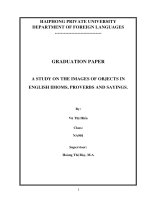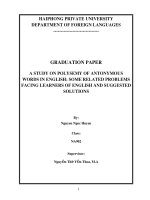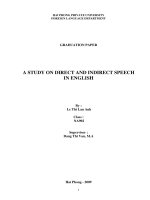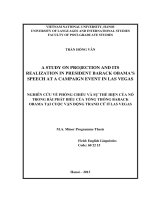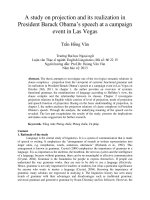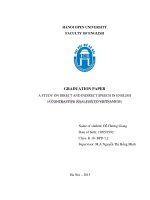a study on direct and indirect speech in english
Bạn đang xem bản rút gọn của tài liệu. Xem và tải ngay bản đầy đủ của tài liệu tại đây (397.72 KB, 60 trang )
1
HAI PHONG PRIVATE UNIVERSITY
FOREIGN LANGUAGE DEPARTMENT
GRADUATION PAPER
A STUDY ON DIRECT AND INDIRECT SPEECH
IN ENGLISH
By :
Le Thi Lan Anh
Class :
NA902
Supervisor :
Dang Thi Van, M.A
Hai Phong - 2009
2
ACKNOWLEDGEMENTS
First of all I would like to express my sincere and special gratitude to Ms
Dang Thi Van, the supervisor, who has generously given us invaluable
assistance and guidance during the preparation for this research paper.
I also offer my sincere thanks to Ms Tran Ngoc Lien, the Dean of Foreign
languages Department and all the teachers at Hai Phong Private University for
their previous supportive lectures that helped me in preparing my graduation
paper.
Last but not least, my wholehearted thanks are presented to my family
members and all of my friends for their constant support and encouragement in
the process of doing this research paper. My success in studying is contributed
much by all of you.
Hai Phong – June 2009
Le Thi Lan Anh
3
SYMBOLS AND ABBREVIATIONS
&
And
A
Adverbial
Ncl
Noun clause
O
Object
Od
Direct object
Oi
Indirect object
P
Predicator
S
Subject
V
Verb
Wh – question
Question word
Ex
Example
i.e.
That is
etc
Et cetera
+
Plus
[ ] Square brackets around the number indicates the number of the reference
books listed in the references. When there are three items in the square bracket
separated by a semicolon, Ex : [Thomson, 1985, p285], the first item indicates
the first author‟s name, the second item indicates the year that book was
published, the later indicates the page.
“ ” or „ ‟ Inverted commas around words, phrases or clause indicate the direct
quotations.
/ Oblique stroke is used to separated alternative words, phrase or terms.
→ The arrow indicates the transfer from the first sentence or structure to the
second.
4
TABLE OF CONTENTS
ACKNOWLEDGMENTS
SYMBOLS AND ABBREVIATIONS
TABLE OF CONTENTS
PART ONE: INTRODUCTION 1
1. Rationale 1
2. Aims of the study 1
3. Scope of the study 2
4. Methods of the study 2
5. Design of the study 2
PART TWO: DEVELOPMENT 4
CHAPTER I : THEORETICAL BACKGROUND 4
I. AN OVERVIEW OF DIRECT & INDIRECT SPEECH IN ENGLISH 4
I.1. Definition 4
I.2. Forms of direct and indirect speech in writing structure 5
I.3. Function of direct and indirect speech 6
II. AN OVERVIEW OF CHANGING FROM DIRECT TO INDIRECT
SPEECH 8
II .1. The use of punctuation marks 8
II .2. Say, tell, and alternative introductory verbs 10
II .3. Question in indirect speech 12
II .4. Commands, requests, advice and suggestion in indirect speech 16
CHAPTER II: CHANGES FROM DIRECT SPEECH TO INDIRECT
SPEECH IN ENGLISH 19
II .1. Changes of clause types 19
II .1.1. Statements 19
II .1.2. Wh – questions 19
II .1.3. Yes – No questions 20
II .1.4. Commands 20
II .1.5. Exclamations 21
5
II .2. Changes in Verb forms (tenses) 22
II .2.1. Tense changes necessary 22
II .2.2. Past tenses sometimes remain unchanged 23
II .2.3. Auxiliary verbs and indirect speech 28
II .3. Changes in use of pointer words 34
II .3.1. Changes of pronouns and possessive adjectives 34
II .3.2. Changes of expressions of time and place in indirect speech 36
II .3.3. Position of what, who and which in indirect speech 38
II .3.4. Nouns clause as object – reported clauses in indirect speech 39
II .4. Mixed types indirect speech 42
II .5. Free indirect speech 43
II .6. Transferred negation 44
CHAPTER III: IMPLICATION OF THE STUDY 45
III .1. Errors in changing the direct into indirect speech 45
III .2. Errors in changing indirect speech into direct speech 47
III .3. Some common suggestions 48
PART THREE: CONCLUSION 49
REFERENCES 50
APPENDIX 52
6
PART ONE: INTRODUCTION
1. RATIONALE
At present, English has become the most widely - used language all over the
world. It has often been referred to a “global language” and used internationally
in business, political, cultural relation and education as well. Thanks to
widespread use of English, different countries can come closer to each other to
work out problems and strive for a prosperous community.
Realizing the significance of English, Vietnamese learners have been trying to
be good at English. Mastering English is the aim of each learner.
However, to Vietnamese learners, English grammar is rather complex, direct &
indirect speech appears to be one of the most difficult criteria, particularly the
way to change direct to indirect speech. In the process of learning English
grammar, learners always face a lot of difficulties such as: tense changes,
possessive adjective changes, changes of personal pronouns, adverbials of time
and place, etc. Therefore, to help the learners clearly understand how to change
direct speech to indirect speech and use indirect speech in writing as well as in
speaking correctly, “ A study on direct and indirect speech in English” is chosen
as the topic of the research paper. Besides, some common mistakes are found
out and some solutions are also given.
2. AIMS OF THE STUDY
The study “A study on direct and indirect speech in English” is aimed at:
1. Helping learners understand how to form direct and indirect speech, use
it correctly as well.
2. Describing and classifying all the cases of the of changing direct to
indirect speech.
3. Finding out common errors made by Vietnamese learners and suggesting
some solutions.
7
3. METHOD OF THE STUDY
With the above aims, my method of the study depends on knowledge collected
from the previous lectures of my teachers and the supportive help of my
supervisor & my friends. I also have looked up some books and references
published by Longman Group (FE) Ltd, Oxford University, etc.
Furthermore, to help learners have clear understanding about direct and indirect
speech, all definitions, analysis & examples of my study are extracted from
words of Quirk, R & Green Baum, S (1973), Alexander, L. G (1988) and
Thomson, A. J. (1985), etc. Finally, there are a number of documents for my
research selected from reliable sources on websites.
4. SCOPE OF THE STUDY
In learning languages, using direct and indirect speech is regarded as one of the
most complicated problems, because direct and indirect speech in each language
has its own features. I have no ambition to cover it in all languages due to the
limitation of time, knowledge and experience. Therefore, I decide to focus on
direct and indirect speech in English and related fields, i.e. definition, basic
form, common rules, etc. Additionally, I also discuss about some difficulties and
errors which Vietnamese learners may face and suggest solutions experienced
during my study process.
5. DESIGN OF THE STUDY
The research study is divided into three parts of which the second part is the
most important one.
Part one is the introduction, which gives the reason for choosing the topic of
the study, pointing out aims of conducting the study, marking out the methods
applied, limiting the study & giving out the design of the study as well.
Part two refers to the main content that consists of three chapters :
Chapter I is the theoretical background knowledge of the study. In this
chapter, emphasis is laid on the definition of direct speech & indirect speech in
English, their basic forms and functions in grammar, besides a quirk overview of
changing from Direct to indirect speech about the use of punctuation marks; say,
tell, and alternative introductory verbs; question in indirect speech; commands,
requests, advice and suggestion in indirect speech.
8
Chapter II is the main part of the study, describes the changes from direct
speech to indirect speech. This chapter deals with six problems :
Changes of clause types.
Changes in verb forms.
Changes in use of pointer words.
Mixed types in indirect speech.
Free indirect speech.
Transferred negation.
Chapter III is the last part of the research paper. It focuses on some errors
made by Vietnamese learners & solutions suggested to over come the problems.
Part three is the Conclusion of the whole study in which I summarize all the
matters discussed on the two previous parts, show reference used in the research
paper and some exercises for practicing well.
9
PART TWO: DEVELOPMENT
CHAPTER I : THEORETICAL BACKGROUND
I. AN OVERVIEW OF DIRECT & INDIRECT SPEECH IN ENGLISH
I.1. Definition
There are many linguists who study direct & indirect speech in English and they
have their own ideas and definitions about them. According to, Thomson (1985,
p269) “In direct speech we repeat the original speaker‟s exact words” Ex : He
said, „I have lost my umbrella‟. His definition is nearly the same with the
website “Saying
exactly what someone has said is called direct speech (sometimes called quoted
speech)” and the website />direct-and-indirect-speech “When we quote word for word what somebody says,
we use inverted commas (quotation marks) and we repeat exactly the original
utterance, this is called direct speech”.
Ex : David (to Tom) : Have you seen The Two Towers? (original utterance).
However, in my opinion, the best way to define direct speech is that we use
direct speech whenever we speak i.e. when we talk directly to the hearer. We
use the term direct speech word in writing, in direct speech we repeat the
original speaker‟s exact words.
Similar with direct speech‟s definition, a number of ways are defined about
indirect speech by Thomson (1985, p269) “In indirect speech we give the exact
meaning of a remark or a speech, without necessarily using the speaker‟s exact
words”.
Ex : He said (that) he had lost his umbrella.
In the website that
definition is “Indirect speech (sometimes called reported speech), doesn't use
quotation marks to enclose what the person said and it doesn't have to be word
for word”.
10
I .2. Forms of direct and indirect speech in writing structure
I .2.1. Forms of direct speech
Quoted structures are sometimes called direct speech. A quoted structure
consists of two clauses, one clause is a reporting clause which contains the
reporting verb. Ex: “I love England”, he said. “he said” is a reporting clause.
The other part is the quote “I love England”, which represents what someone
says or has said.
[Hartley, 2005, p83]
Here is the table of form of direct speech in writing structure :
[Alexander, 1988, p284]
Furthermore, according to Quirk (1985, p1022) the reporting clause may occur
before, within, or after the direct speech. Medial position is very frequent. When
the reporting clause is positioned medially or finally, subject – verb inversion
may occur if the verb is in the simple present or simple past:
Ex : „As a result,‟ said John / John said, “I am very angry”. (*)
He said,
[Quirk, 1973, p341]
„The radio is too loud,‟ Elizabeth complained / she complained
Complained Elizabeth.
[Quirk, 1985, p1022]
Inversion is most common when the verb is said, the subject is not a pronoun
and the reporting clause is medial, as in (*). It is unusual and archaic, however,
when the subject of the reporting clause is a pronoun, even when the verb is said
(Ex : said he).
Actual spoken statement
Actual spoken question
„I‟m waiting.‟
„When did you arrive, John?‟
Direct statement in writing
Direct question in writing
„I‟m waiting.‟ John said.
„When did you arrive, John?‟ Mary
asked.
11
I .2.2. Forms of indirect speech
The major differences in English between the basic forms of Direct (or quotes)
Speech and Indirect (or reported) speech is that the indirect forms have no
quotation marks and are introduced by a QUOTATIVE FRAME which consists
of an attributed speaker (he, she, the boss) and a verb of saying (said, asked),
followed by a conjunction (that, if). The intonation of the indirect speech form
will be noticeably different from the direct speech form, particularly in the case
of reported questions.
[Yule, 1998, p272]
Within the reported clause, a number of distinct shifts can be found.
Ex :
a. Clinton said, “I am very busy now.”
b. Clinton said that he was very busy then.
[www.english-for-students.com/DirecttoIndirectSpeech.html]
a. „I have lived here for years,‟ Ms Duncan said.
b. Ms Duncan told me (that) she had lived there for years.
[Alexander, 1988, p290]
a. She said, “It'll rain tomorrow.”
b. She told me it would rain the following day.
[www.english-the-international-language.com/repsp.html]
The above examples illustrate tense forms of the verb (present → past tense),
other time references (tomorrow → the following day, now → then), place
references (here → there), pronouns (I → He, you → her), etc.
I .3. Function of direct and indirect speech
I .3.1. Function of direct speech
According to Quirk (1985, p1022) the direct speech functions as a subordinate
clause:
Direct speech seems to be a direct object.
Ex : She said, “I've been teaching English for seven years.”
[www.learnenglish.de/grammar/reportedspeech.htm]
12
Direct speech can function as subject complement in a pseudo-cleft
construction.
Ex : What Dorothy said was „My mother‟s on the phone.‟
[Quirk, 1985, p1022]
Direct speech may be appositive to a unit that is clearly a part or the
whole of the direct object:
Ex : Dorothy used the following words : „My mother‟s on the phone.‟
[Quirk, 1985, p1023]
On the other hand, we can view the reporting clause as subordinate, functioning
as an adverbial. Thus, like most adverbials it can be positioned variously and
can at least sometimes be omitted.
Ex : „Generals,‟ they alleged, „never retire ; they merely fade away.‟
Moreover, the direct speech clause behaves like a main clause in that it can, for
example, be a question or directive:
Ex : He asked, “Why are you studying English?”
[www.english-for-students.com/DirecttoIndirectSpeech.html]
Ex : Dorothy said, „Tell my mother I‟ll be over soon.‟
[Quirk, 1985, p1023]
But, of course, the reporting clause behaves likewise:
Ex : Did you really say to Simon, “You like photography and collecting
stamps”?
[www.english-the-international-language.com/repsp.html]
Ex : Tell Richard, „It's too late to catch the train‟
[www.perfect-english-grammar.com/reported-speech.html]
I .3.2. Function of indirect speech
Typically, indirect speech is used to report statements, and takes the forms of a
nominal that-clause.
Indirect speech is a direct object
Ex: The teacher said that phrasal verbs are very important.
[
13
It is an extrapolated subject & subject complement.
Ex : It was said that the earthquake happened at half past seven
[www.eslbase.com/grammar/reported-speech]
Ex : What neighbors said was that as a teenager he had earned his pocket
money by delivering newspapers.
[Quirk, 1985, p1025]
II . AN OVERVIEW OF CHANGING FROM DIRECT TO INDIRECT
SPEECH
II .1. The use of punctuation marks
A. Quotation marks (or “inverted commas”) go round what is actually spoken
and enclose other punctuation marks such as commas(,), full stop (.), question
marks(?) and exclamation mark (!). They may be single(„……‟), or double(“
…….”) and are placed high above the base line at the beginning and end of each
quotation.
Ex : Jack said, “My wife went with me to the show yesterday.”
Or : Jack said, „My wife went with me to the show yesterday.‟
[
B. What is said, plus reporting verb and its subject, is considered as a whole
unit. When the subject + reporting verb comes at the beginning of a sentence,
the reporting verb is always followed by a comma (sometimes by a colon (:) in
American English) and the quotation begins with a capital letter.
Ex : The teacher said, “Review exercises two and three for the test!”
[www.english-the-international-language.com/repsp.html]
When the subject + reporting verb comes after what is said, the quotation has a
comma before the second quotation mark.
Ex : „I should go to the dentist‟, John said.
[www.eslbase.com/grammar/reported-speech]
But if the quotation ends with an exclamation mark or a question mark, a
comma is not used as well.
14
Ex : “Where can I get a taxi ?‟ John asked.
“What a lovely garden!” he said.
[Allen, 1962, p270]
Subject + verb can come in the middle of a quotation-sentence :
Ex : „Meet me at the station‟, he said, „10 a.m. tomorrow‟.
[www.perfect-english-grammar.com/reported-speech.html]
The second part of the quotation does not begin with a capital letter because it is
not a separate sentence.
C. If there is a “quote within quote”
(That is if we are quoting someone‟s exact words)
We use a second set of quotation marks. If double quotation marks have been
used on the “outside”, single ones are used on the “inside” and vice versa. The
inside quotation has its own punctuation, distinct from the rest of the sentence.
Ex : Ann said, „Just as I was leaving, a voice shouted, “Stop!”‟.
„What do you mean, “Are you all right”?‟ Ann asked.
[Alexander, 1988, p284]
We can also use a second set of quotation marks when we mention the title of a
book, film or play.
Ex : „How long did it take you to read “War and Peace”?‟ I asked.
[Alexander, 1988, p285]
However, this is often a matter of personal taste. In print, titles often appear in
italics without quotation marks.
D. Noun + reporting verb may be in subject + verb order or may be inverted
(verb + subject ).
Ex : “We have finished our work”, John said. Or
“We have finished our work”, said John.
[Allen, 1962, p254]
If the subject is a long one, then inversion is usual.
Ex : “Where‟s this train going ?” asked the lady sitting beside me.
[Alexander, 1988, p285]
15
With a pronoun subject, inversion is rare in modern English.
Ex : “Where are you going, Ann?” I asked.
[www.english-for-students.com/DirecttoIndirectSpeech.html]
Some reporting verbs, particularly those requiring an object, such as assure,
inform and tell can not be inverted. Adverbs of manner usually come at the end.
Ex : “Try again”, said Ann‟s friends encouragingly.
[Thomson, 1985, p281]
E. Quotation marks are generally not required with reporting verbs such as ask
oneself, think and wonder when they are used to describe “direct thoughts” in
“free indirect speech”.
Ex : So that was their little game, he thought.
Where are they now, he wondered.
[Alexander, 1988, p285]
II .2. Say, tell, and alternative introductory verbs
II .2.1. Say and tell with direct speech
II .2.1.1. Say with direct speech
Say is commonly associated with direct speech in writing.
Ex : Jim said, “I like beer”.
[www.english-the-international-language.com/repsp.html
We can also use say with short, ordinary questions in direct speech (not long and
complicated ones) : “Are you all right?‟ he said /asked. (Not *told me*)
[Alexander, 1988, p288]
Moreover, say can introduce a statement or follow it:
Ex : Harriet said, „I'm getting married tomorrow‟
Or : „I'm getting married tomorrow‟ Harriet said.
[www.english-the-international-language.com/repsp.html]
Particularly, inversion of say and noun subject is possible when say follows the
statement : „I‟ve just heard the news,‟ said Tom.
[Thomson, 1985, p276]
16
Say + to + person addressed is possible, but this phrase must follow the direct
statement; it can not introduce it.
Ex : „You are wrong, John,‟ Mary said to me (Inversion is not possible here)
[Quirk, 1973, p342]
II .2.1.2. Tell with direct speech
Tell requires the person addressed : Tell me; He told us; I‟ll tell Tom. But except
with tell lies/stories/the truth, when the person addressed need not be mentioned
: He told (me) lies; I‟ll tell (you) a story.
Furthermore, tell used with direct speech must be placed after the direct
statement.
Ex : „I like your tie,‟ she told John.
[Quirk, 1985, p1029]
Note : Inversion is not possible with tell.
Especially, say or tell can be used in direct speech and can also introduce direct
commands.
Ex : „Why don‟t you take off your coat?‟ he told me/he said (to me).
[Thomson, 1985, p281]
II .2.2. Say and tell with indirect speech
Say and tell someone + optional that can introduce indirect statements. We
never use comma after say or tell someone.
Ex : Jack said (that)/told me (that) his wife had gone with him to the show.
[
If we need to mention the listener, tell + indirect object is generally preferable to
say + to someone.
Ex : He said he‟d just heard the news.
He told me that he‟d just heard the news.
[Thomson, 1985, p276]
Note : tell…how/about :
Ex : He told us how he had studied English well.
He told us about studying English well.
[
17
II .2.3. Alternative introductory verbs
There are many other verbs we can use apart from said and told. Here is a list of
verbs which are often used as reporting verbs:
Accused, admitted, advised, alleged, agreed, apologized, begged, boasted,
complained, denied, explained, implied, invited, ordered, promised, replied,
suggested, thought ,etc.
These can be used with direct or indirect speech. With direct speech they follow
direct statements, but in indirect speech, they can all introduce indirect
statements and that should be placed after the verb.
Ex : „His horse died in the night,‟ he assured us.
[www.english-for-students.com/DirecttoIndirectSpeech.html]
Ex : Tom assured us that it wouldn‟t cost more. But Bill objected/pointed out
that it would take longer.
[Thomson, 1985, p277]
II .3. Question in indirect speech
Questions in reported structures are sometimes called reported questions or
indirect questions. The indirect question is really not a question at all. In a direct
question, quotation marks and question marks are not used, as well as we put the
auxiliary verb before the subject. That is be, have and modal auxiliaries in the
direct question change back to statement word order (subject + verb); do, does
and did disappear in reported questions. If there is no auxiliary verb, we put do
before the subject.
Ex : I wonder why you don‟t listen to me.
He wanted to know why the French ate frogs.
[www.perfect-english-grammar.com/reported-speech.html]
There are two main types of questions. Therefore, reported structures for
questions are two main types.
18
II . 3.1. Reported Yes – No questions
When we report a “Yes – No questions” we use an “If” – clause beginning with
the conjunction “If” or a “Whether” – clause beginning with the conjunction
“Whether”.
The examples in the following table will show you a more concrete form of
indirect Yes – No questions.
Indirect question
He asked me if/whether I was ready.
He asked me if/whether I had finished.
He asked me if/whether I played chess.
He asked me if/whether he could have it.
[Alexander, 1988, p293]
Note : Normally we can use either if or whether in indirect Yes – No questions
but if is more usual.
Ex : He asked me if/whether I would come to the party.
[www.learnenglish.de/grammar/reportedspeech.htm]
We use “if” when the speaker has suggested one possibility that may be true.
Ex : He asked if he should open the window.
[Allen, 1962, p261]
We use “whether” to emphasize that choice has to be made and to convey
slightly greater doubt.
Ex : She asked me whether I wanted tea or coffee.
[Alexander, 1988, p294]
He asked whether or not I she was satisfied.
[Quirk, 1985, p1030]
Additionally, whether + infinitive is possible after wonder, want to know.
Ex : He wondered whether to wait for them or go on.
Or : He wondered whether he should wait for them or go on.
[Thomson, 1985, p278]
19
Lastly, “whether” is neater if the question contains a conditional clause as
otherwise there would be two ifs.
Ex : Bill asked whether, if I got the job, I‟ve move to New York.
[Thomson, 1985, p278]
Question beginning Shall I / We? in indirect speech.
Question beginning Shall I / We? can be of four kinds:
Speculations or requests for information about a future event.
Ex : He wondered if he would ever forget her.
[Allen, 1962, p261]
Request for instruction or advice.
Ex : “Tell me what to do with it”.
[Thomson, 1985, p279]
These are expressed in indirect speech by ask, inquire etc, with should or the be
+ infinitive construction. Requests for advice are normally reported by should
Ex : Mary asked Bill if he should help her with her homework.
[www.english-the-international-language.com/repsp.html]
When a choice is required we normally use whether in indirect speech, whether
+ infinitive is sometimes possible.
Ex : He asked whether he should / was to lock the car or leave it unlocked. Or :
He asked whether to lock the car or leave it unlocked.
[Thomson, 1985, p279]
Offers.
Ex : The porter offered to carry the guest's cases to her room.
[www.english-the-international-language.com/repsp.html]
Suggestions.
Ex : He suggested I should come to the party.
[www.learnenglish.de/grammar/reportedspeech.htm]
Questions beginning will you/could you?
These may be ordinary questions, but many also be requests, invitations, or,
very occasionally commands.
20
Ex : He said, „Will you be there tomorrow?‟ (ordinary question)
→ He asked if she would be there the next day.
[Thomson, 1985, p279]
Ex : “Would you mind closing the window please?” or “Could you close the
window please?”
→ She asked me to close the window.
[www.perfect-english-grammar.com/reported-speech.html]
II .3.2. Reported “Wh” – questions.
When we report a “Wh”- question we use a “wh” – word at the beginning of the
reported clause.
The following examples will show the form of “wh”-questions in indirect
speech.
→ She asked me where I came from.
→ I was wondering why don‟t take the train; it'll be quicker
→ He wanted to know what I thought of it.
→ She asked me when she must be/ had to be there.
[www.perfect-english-grammar.com/reported-speech.html]
Here is the list of some verbs which can be used before clauses beginning with
“wh” – words :
Decide, discover, discuss, explain, forget, guess, imagine, know, learn, realize,
remember, reveal, say, see, suggest, teach, tell, think, understand, wonder, ask,
etc.
Ex : I wondered what had happened.
[Cobuild, 1990, p323]
According to Alexander (1988, p296), beside two above main types, indirect
questions also includes reported subject – questions in which tense changes and
changes in modals occur in the usual way, but the word order of the direct
question is retained.
Ex : An old mouse asked who would bell the cat.
[www.english-for-students.com/DirecttoIndirectSpeech.html]
21
Especially, reporting verbs other than ask can be used to introduce indirect
subject – question : Please tell me who delivered this package.
I want to know which piece fits in this puzzle.
[Alexander, 1988, p296]
II .4. Commands, requests, advice and suggestions in indirect speech
II .4.1. Reported commands, requests and advice
If someone orders, requests or advises someone else to do something, this can be
reported by using a “to” infinitive clause. Indirect commands, requests, advice
are usually expressed by a verb of command / request / advice + object +
infinitive (= the object + infinitive construction). The following verbs can be
used : advise, ask, beg, command, encourage, entreat, forbid, implore, invite,
order, recommend, remind, request, tell, urge, warn, etc. They must be
followed directly by the person addresses without preposition. Therefore, we
must add a noun or pronoun when reporting such commands/requests.
Ex : “Call the first witness”, said the Judge → The Judge commanded them to
call the first witness.
[www.english-for-students.com/DirecttoIndirectSpeech.html]
Ex : He told me/him/her/us/them/the children to go away.
[Thomson, 1985, p280]
In case of negative commands, requests etc, they are often reported by not +
infinitive
Ex : The man with the gun said to us, “Don't move!” → The man with the gun
warned us not to move.
[www.hulya.cankaya.edu.tr/ingilizece4.htm]
II .4.2. Other ways of expressing indirect commands
A. Say / tell + subject + be + infinitive.
Ex : He said I was to wait for him.
[Alexander, 1988, p296]
This is a possible alternative to the tell + infinitive construction, so that:
He said, „Don‟t open the door‟ could be reported
He told me not to open the door. Or : He said that I wasn‟t to open the door.
[Thomson, 1985, p282]
22
Particularly, the be + infinitive construction is useful in the following cases:
(1). When the command is introduced by a verb in the present tense:
Ex : He says that he has passed the examination.
[www.english-for-students.com/DirecttoIndirectSpeech.html]
(2). When the command is preceded by a clause (usually of time or condition)
Ex : He said that if he were/had been in New York, he would visit/would have
visited the current exhibition at the Metropolitan Museum.
[Quirk, 1985, p1031]
This indirect command would be equally possible here but note that if we use
the tell + infinitive construction we must change the order of the sentence so as
to put the command first. Sometimes this would result in rather confusing
sentence.
For example, the request If you see Ann, tell her to ring me would become He
told me to tell Ann to ring him if I saw her. Such requests can only be reported
by the be + infinitive construction. The example above could become He said
that if I saw Ann I was to tell her to ring him.
[Thomson, 1985, p282]
B. Say/tell (+that) + subject + should
This structure can be used to express indirect commands in the following cases:
(1). Say or tell with a should construction normally indicates advice rather than
command.
Ex : He said, „If your brakes are bad don‟t drive so fast‟.
→ He said/told me that if my brakes were bad I shouldn‟t drive so fast. Or
→ He advised me not to drive so fast if my brakes were bad.
[Thomson, 1985, p282]
(Note : change of order here, as with tell + infinitive above).
(2). Advice can also be expressed by advise, recommend and urge + that +
should. This is particularly useful in passive.
Ex : He advised that her car should be repaired.
[www.eslbase.com/grammar/reported-speech]
23
(3). Command and order can also be used with should or a passive infinitive.
Ex : The teacher ordered that every student should do it again.
Or The teacher ordered that it should be done again .
Or The teacher ordered it to be done again.
[Allen, 1962, p252]
II .4.3. Reporting suggestions
When someone makes a suggestion about what their hearer should do, we report
it by using a “that” – clause. This clause often contains a modal, usually
“should”.
Ex : He proposed that the government should hold an inquiry.
[Cobuild, 1990, p325]
Furthermore, we can use let‟s to express a suggestion and it is reported by the
structures:
S + Suggest + Ving.
Or S + Suggest + that + S + Should + V.
Ex : Carol suggested that I should have another apple.
[Quirk, 1985, p1030]
Similarly in the negative.
Ex : He suggested not saying anything about it till they heard the facts.
Or He suggested that they shouldn‟t say about it till they heard the facts.
[Thomson, 1985, p283]
But let‟s not used alone in answer to an affirmative suggestion is often reported
by some phrase such as opposed the idea / was against it / objected so that we
could report.
Ex : John suggested going to cinema but Carol was against it.
[www.perfect-english-grammar.com/reported-speech.html]
24
CHAPTER II : CHANGES FROM DIRECT TO INDIRECT SPEECH IN
ENGLISH
When changing one direct sentence into an indirect sentence, it is necessary to
take many changes such as : changes of clause types, changes in verb forms,
changes in use of pointer words, etc.
II .1. Changes of clause types
In chapter I, an overview of changing from direct to indirect speech in English is
given. Now, let‟s have a look at it clearly and systematically.
Direct speech
Indirect speech
Independent clause in which one is of
the types :
Main clause + subordinate clause,
the later becoming :
II .1.1. Statements
In the direct sentence, we need to use
quotation marks. The position of
subject and reporting verb is
changeable. It may come after or
before the quotation.
Ex : Ann said, “I want to go to New
York next year”.
Or “I want to go to New York next
year”, said Ann.
[Murphy, 1998, P94]
That clauses
In the indirect sentence, quotation
marks disappear and we use “that” to
connect two clauses together. But
“that” sometimes is omitted. Besides,
there are changes of tenses,
pronouns, etc.
Ex : Ann said that she wanted to go
to New York the following year.
Or : Ann said that she wants to go to
New York the following year.
II .1.2. Wh – questions
In direct questions, we still need
quotation marks. The position of the
subject and reporting verbs is
changeable i.e. it may stand before or
after the quotation.
Wh- interrogative clauses
In indirect questions, we don‟t need
quotation marks and the word order
is changed. The inversion after a
question word in a direct question
changes back to statement word
25
Ex : “where is Julie?” she ask me.
www.perfect-english-
grammar.com/reported-speech.html
order in a reported question. If
necessary, the tense changes at the
same time. And modal auxiliaries
disappear indirect speech.
Ex : She asked me where Julie was.
II .1.3. Yes – No questions
In direct Yes – No question, we still
need quotation mark, question mark.
The position of the subject and
reporting verb is changeable, too. It
can stand before or after the
quotation.
Ex : „She asked, “Do you want to
come with me?”
www.eslbase.com/grammar/reported-
speech
If / whether clauses
In indirect Yes – No question,
quotation mark and question mark
are not used. There is a change in
word order. The inversion in the
direct question changes back to
statement word order (subject +
verb) in the reported question and if
necessary, the tense is changed at the
same time. Auxiliaries disappear in
indirect question. If or whether is
used to connect the two clauses.
Ex : She asked me if I wanted to
come with her.
II .1.4. Command.
Direct commands are those in which
the speaker chooses to express the
illocutionary force of command. The
speaker can say what she/he wants
the hearer to do using imperative.
The imperative is the form which
conventionally determines the
illocutionary force of an utterance as
a request command or advice etc.
To infinitive clauses.
When a direct command is turned
into an indirect one, the following
will be notice :
(a). The verb used is not say (with to)
but one like order, command, tell,
ask, request, according to the shape
of meaning intended.
(b). A direct object, representing the
person ordered, is introduced.
(c). The imperative form of the verb
